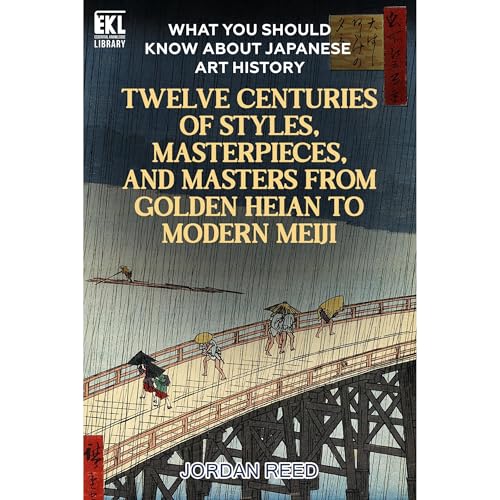
What You Should Know About Japanese Art History
Twelve Centuries of Styles, Masterpieces, and Masters from Golden Heian to Modern Meiji
No se pudo agregar al carrito
Add to Cart failed.
Error al Agregar a Lista de Deseos.
Error al eliminar de la lista de deseos.
Error al añadir a tu biblioteca
Error al seguir el podcast
Error al dejar de seguir el podcast
$0.00 por los primeros 30 días
Compra ahora por $5.99
-
Narrado por:
-
Virtual Voice
-
De:
-
Jordan Reed

Este título utiliza narración de voz virtual
Discover how twelve centuries of Japanese art hold the keys to understanding everything from Zen mindfulness to your iPhone’s sleek design. What You Should Know About Japanese Art History invites you on a captivating journey from the Heian court’s gilded screens (794) to Meiji Japan’s revolutionary collision of ink and oil (1912). Imagine walking beside noblewomen composing waka poetry in vermilion-lit palaces, where Yamato-e scrolls captured love’s fleeting beauty. Feel the spiritual intensity of Kamakura’s lifelike Buddhas—carved for samurai seeking solace—and lose yourself in Edo’s "floating world," where Hokusai’s monumental waves crashed into Van Gogh’s dreams and Hiroshige’s rain-soaked bridges birthed Impressionism.
This book transforms art into a living philosophy. You’ll learn to recognize how wabi-sabi finds poetry in cracked teacups, how ma (sacred space) turns silence into resonance, and why Rinpa’s gold-leafed irises still inspire designers from Milan to Tokyo. Witness Meiji artists fracture into traditionalists guarding mineral-pigment secrets and radicals embracing Western oils—a creative clash echoing in today’s manga studios and digital interfaces. Through 50+ landmark works—like Kōrin’s abstracted nature and Kuroda’s scandalous nudes—you’ll grasp how isolation and openness forged Japan’s artistic DNA.
Here’s why readers call it transformative:
- Travelers gain "X-ray vision" for Kyoto temples or Tokyo’s museums, seeing beyond surfaces to hidden meanings in a samurai’s sword curve or a tea master’s bowl.
- Artists/designers borrow shibui simplicity and ukiyo-e composition tricks that made brands like Muji and Apple globally irresistible.
- History lovers decode how Edo’s woodblock culture foreshadowed manga’s visual storytelling—proving scrolls and anime share narrative bloodlines.
- Mindful seekers adopt wabi-sabi to cherish life’s "flaws" and yūgen to find awe in misty morning streets.
Unlike dense academic texts, this guide mesmerizes with vivid storytelling while uncompromising on depth. Kyoto art historian Kenji Tanaka praises it as "the rare work that ignites beginners’ curiosity without ever simplifying genius." Whether you’re planning a trip to Naoshima’s art islands, creating your next project, or seeking wisdom for modern chaos, these pages offer more than knowledge—they offer a new lens to see our world.


